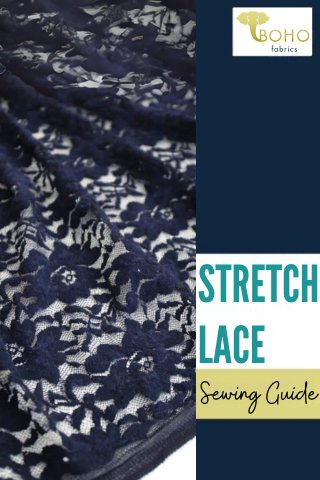February's Featured Fabric: Stretch Lace!

Today, I'm diving into a fabric that's both beautiful and a bit tricky: Sewing with Stretch Lace. If you've ever worked with it, you know it's not the easiest fabric, but the results are so worth it. With the right techniques and a bit of patience, you can sew with this fabric and create stunning pieces.
Stay tuned for another blog post next week for an in-depth comparison of our laces in the shop and how to prep your fabric and cutting tips!
1. Choosing the Right Stretch Lace
Not all stretch laces are created equal. They vary in elasticity, pattern, and weight. Some have more give, perfect for snug fits, while others are lightly elastic. For example, our shop offers several types of stretch lace in different weights and patterns.
P.S.: Most of the laces shown in the photos below are our Peony Petals Stretch Lace, one of our higher-end lace offerings at the shop.

2. Selecting the Right Sewing Machine Needle
A stretch or ballpoint needle is ideal for sewing stretch lace to prevent snagging or breaking the delicate threads. Choose a size appropriate for the lace's weight—usually a 70/10 or 75/11 needle.

3. Adjusting Stitch Settings
Use a narrow zigzag stitch or a stretch stitch setting on your sewing machine. This allows the seam to stretch with the fabric, preventing popped stitches. Test stitch length and width on a scrap piece of your lace to find the perfect setting.
When you're sewing, let the fabric feed itself as much as possible. Pushing or pulling can lead to uneven seams or distortion. A walking foot can be a big help here.

4. Stabilizing Seams
Stabilizing seams with clear elastic or interfacing is crucial, especially for areas that will stretch more. It helps your garment maintain its shape without restricting the stretch. The side and shoulder seams are where I find myself adding clear elastic for extra stability.

5. Finishing Edges
Stretch lace edges often don't fray, which means you can leave them raw for a delicate finish. However, consider using a narrow hem, picot edge, or lace trim for a more polished look or to prevent stretching.
Boho Stitch Tip: Choose a lace with a scalloped edge built into the design. These laces may be a little more expensive per yard, but you are saving time on not having to hem, which is PRICELESS.

Happy sewing, and please share your stretch lace creations with us in our online community via our Facebook Group or on Instagram with the tag @bohofabrics, #bohofabrics, and #boholace. We love seeing all of your creations!!!

Comments
Good day
I made a dress with stretch lace and found by the end of the day the dress was longer. How do I prevent that? Do I use a smaller size pattern for a better fit?
Looking forward to your advice
Kind regards
Margareta